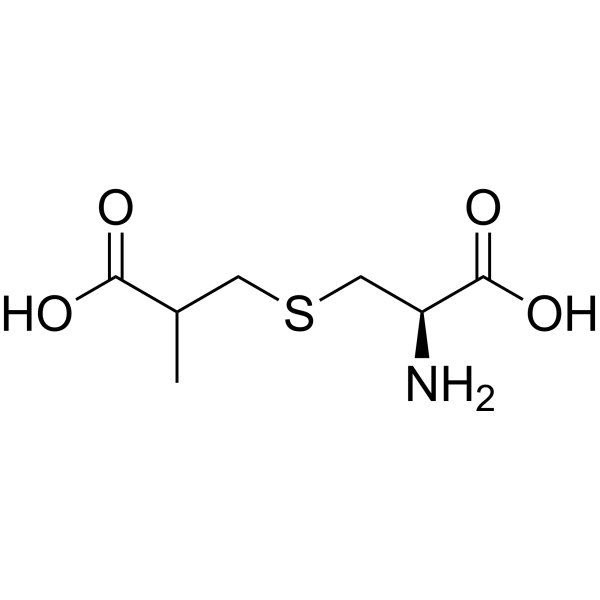
S-(2-Carboxypropyl)cysteine
CAS No. 6852-42-2
S-(2-Carboxypropyl)cysteine( S-(2-carboxypropyl)-L-cysteine )
Catalog No. M29485 CAS No. 6852-42-2
S-(2-Carboxypropyl)cysteine is a urinary metabolite of S-(2-Carboxypropyl)glutathione.
Purity : >98% (HPLC)
 COA
COA
 Datasheet
Datasheet
 HNMR
HNMR
 HPLC
HPLC
 MSDS
MSDS
 Handing Instructions
Handing Instructions
| Size | Price / USD | Stock | Quantity |
| 10MG | 39 | Get Quote |


|
| 25MG | 68 | Get Quote |


|
| 50MG | 106 | Get Quote |


|
| 100MG | 170 | Get Quote |


|
| 200MG | 250 | Get Quote |


|
| 500MG | 428 | Get Quote |


|
| 1G | Get Quote | Get Quote |


|
Biological Information
-
Product NameS-(2-Carboxypropyl)cysteine
-
NoteResearch use only, not for human use.
-
Brief DescriptionS-(2-Carboxypropyl)cysteine is a urinary metabolite of S-(2-Carboxypropyl)glutathione.
-
DescriptionS-(2-Carboxypropyl)cysteine is a urinary metabolite of S-(2-Carboxypropyl)glutathione.
-
In Vitro——
-
In Vivo——
-
SynonymsS-(2-carboxypropyl)-L-cysteine
-
PathwayProteasome/Ubiquitin
-
TargetEndogenous Metabolite
-
RecptorEndogenous Metabolite
-
Research Area——
-
Indication——
Chemical Information
-
CAS Number6852-42-2
-
Formula Weight207.25
-
Molecular FormulaC7H13NO4S
-
Purity>98% (HPLC)
-
SolubilityIn Vitro:?DMSO : 25 mg/mL (120.63 mM)
-
SMILESN[C@@H](CSCC(C(O)=O)C)C(O)=O
-
Chemical Name——
Shipping & Storage Information
-
Storage(-20℃)
-
ShippingWith Ice Pack
-
Stability≥ 2 years
Reference



-
Adenosylcobalamin
Adenosylcobalamin is a biologically active form of vitamin B12 .It is a cofactor for methylmalonyl CoA mutase.?It belongs to the corrinoid group of compounds, which contain a corrin macrocycle, and is produced only by certain bacteria and archaea.?
-
2-Deoxyguanosine
2'-Deoxyguanosine (Guanine deoxyriboside) is a purine nucleoside that is recognized by members of the 2'-dG-II family.2'-Deoxyguanosine has been associated with aging, mutation, and carcinogenesis, and is oxidized by molecular oxygen.
-
1-Methylhistamine di...
1-Methylhistamine dihydrochloride is a major metabolite of histamine by histamine N-methyltransferase in the pathway of histidine metabolism.?It has been used as a biomarker of histaminergic system activity in the brains of Alzheimer's disease patients as well as those with hypersomnia and other neurological conditions.



 Cart
Cart
 sales@molnova.com
sales@molnova.com


